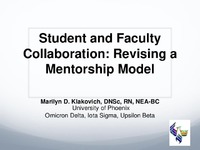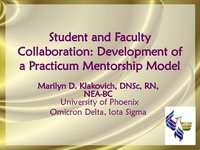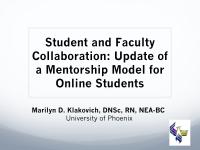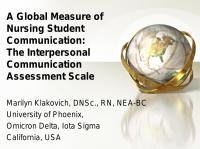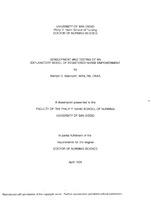| dc.contributor.author | Klakovich, Marilyn D. | en |
| dc.date.accessioned | 2014-11-17T13:44:58Z | |
| dc.date.available | 2014-11-17T13:44:58Z | |
| dc.date.issued | 2014-11-17 | |
| dc.identifier | INRC14A10 | |
| dc.identifier.uri | http://hdl.handle.net/10755/335128 | |
| dc.description | <p>International Nursing Research Congress, 2014 Theme: Engaging Colleagues: Improving Global Health Outcomes. Held at the Hong Kong Convention and Exhibition Centre, Wanchai, Hong Kong</p> | en |
| dc.description.abstract | <p>Session presented on Thursday, July 24, 2014:</p>
<p><strong>Purpose:</strong> Students completing a master's in nursing degree in my online program are required to complete a practicum project working with a master's prepared mentor. During the practicum, students implement a scholarly project to meet an educational need or administrate a project in a facility, such as the workplace, or in the community. Given that students have no face-to-face contact with faculty who supervise the capstone practicum course, effective mentors are critical to student success. The purpose of this presentation is to describe the collaborative process used to revise a practicum mentoring model and outcomes from use of this model.</p>
<p><strong>Methods:</strong> The practicum course is divided into two parts. During part A, students develop a self-directed learning agreement. In part B, students report on their projects and submit all evidence of fulfillment of their learning agreement. The model was initially developed through a qualitative study that included content analysis of student reports (n=263 representing 28 part A classes) of characteristics of effective mentors and then Part B student confirmation of the identified categories. The major categories of characteristics of effective mentors were organized into a pyramid-shaped mentorship model for online program practicum experiences. The base or foundation of the pyramid is comprised of mentor characteristics including background, experience, and education. The central core of the pyramid is formed by mentor qualities and ways the mentor interacts with the mentee (resourceful, inspires and challenges, caring relationship). I presented this model at an international conference and dialogue with the audience suggested the need to refine the model. Consistent with the collaborative approach used for initial development, to allow for student collaboration in model refinement, I posted the model and supporting materials in 5 (n=65) practicum B classes for student input. Based on their recommendations, the mentor qualities and characteristics are reorganized within the pyramid. They believed that the bottom of the pyramid that includes the two cornerstones is the foundation of the model. Thus, the two cornerstones are now nursing knowledge and nursing experience, for without these two key elements, there is not a profession known as nursing. Interconnected between the two cornerstones, in the middle and a very important part of the foundation is caring. The core of the model is now Resourceful with the apex being Inspire and challenge. Professional ladder categories (educator, clinician, researcher, manager) support the base and the core of the model. Once these changes were made, I posted the model in 4 (n = 52) practicum B classes and students confirmed that this model represented their positive experience with their mentor.</p>
<p><strong>Results:</strong> Students in part A of the practicum have been using the model to help them select an appropriate mentor for their project experience. Additionally, they have been sharing the model with their mentors and use it to establish a relationship and determine the best ways that they can work together throughout the project. Students and mentors report that this provides clarity on how to work together, and gives them additional ideas for creative approaches to use. Since using this model, I have had fewer students report negative mentoring experiences in part B.</p>
<p><strong>Conclusion:</strong> Mentors play a critical role in guiding, supporting and challenging students to grow personally and professionally throughout the practicum experience, culminating in attainment of a master's degree in nursing. This refined mentorship model that is specific to a practicum conducted in the context of an online program facilitates appropriate selection of mentors and suggests ways that mentors and mentees can work effectively together.</p> | en |
| dc.language.iso | en | en |
| dc.subject | Collaboration | en |
| dc.subject | Mentoring | en |
| dc.title | Student and faculty collaboration: Revising a mentorship model | en |
| dc.title.alternative | Transforming nursing through education and collaboration | en |
| dc.type | Presentation | en |
| dc.rights.holder | <p>
All rights reserved by the author(s) and/or publisher(s) listed in this item record unless relinquished in whole or part by a rights notation or a Creative Commons License present in this item record.
</p><p>
All permission requests should be directed accordingly and not to the Sigma Repository.
</p><p>
All submitting authors or publishers have affirmed that when using material in their work where they do not own copyright, they have obtained permission of the copyright holder prior to submission and the rights holder has been acknowledged as necessary.
</p> | en |
| dc.description.note | <p>Items submitted to a conference/event were evaluated/peer-reviewed at the time of abstract submission to the event. No other peer-review was provided prior to submission to the Henderson Repository.</p> | |
| dc.type.category | Full-text | en |
| dc.evidence.level | N/A | en |
| dc.research.approach | N/A | en |
| dc.contributor.department | Iota Sigma | en |
| dc.author.details | Marilyn D. Klakovich, DNSc, RN, NEA-BC | en |
| dc.conference.name | 25th International Nursing Research Congress | en |
| dc.conference.host | Sigma Theta Tau International | en |
| dc.conference.location | Hong Kong | en |
| dc.date.conferenceyear | 2014 | |
| dc.description.reviewtype | Abstract Review Only: Reviewed by Event Host | en |
| dc.description.acquisition | Proxy-submission | en |
